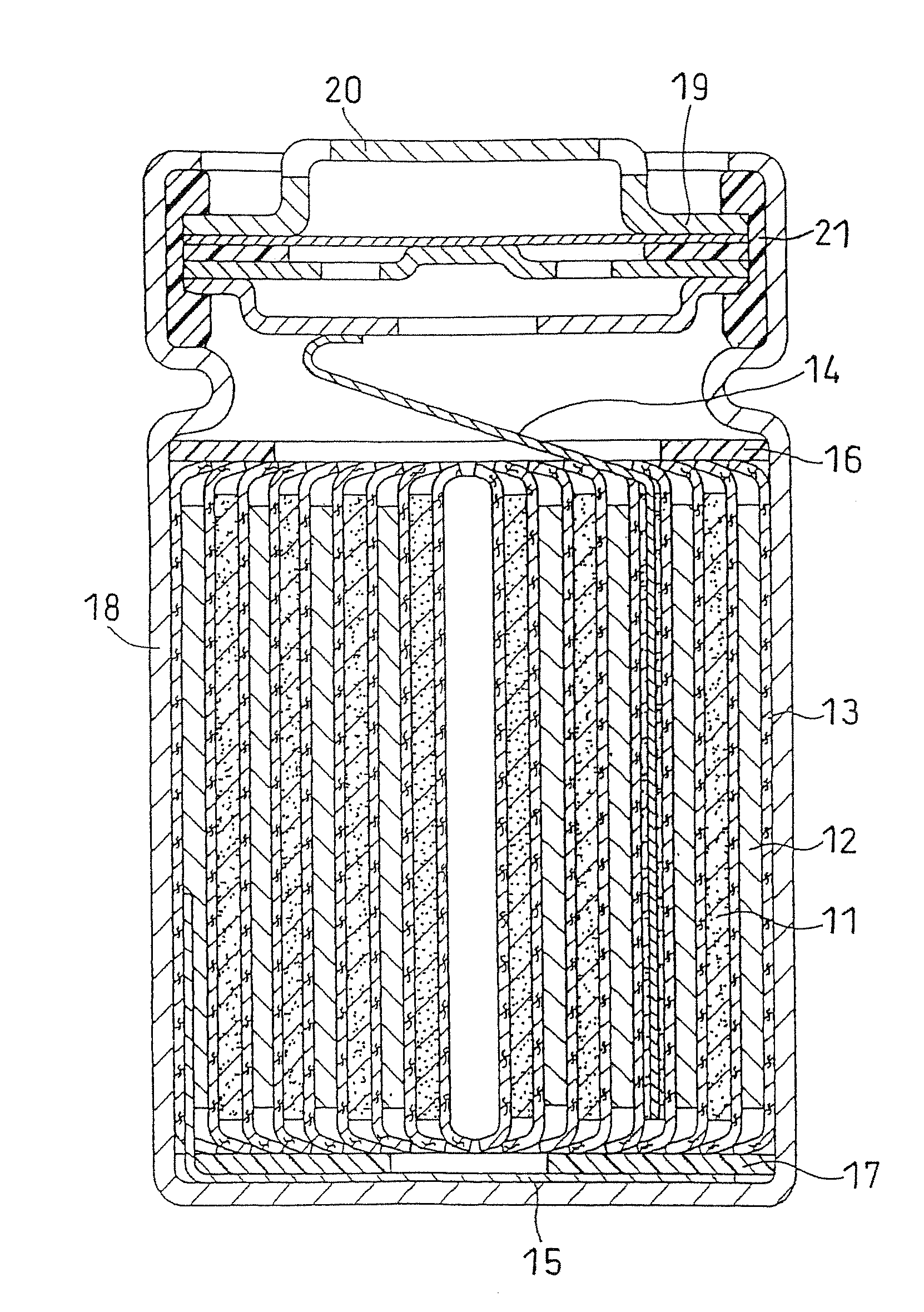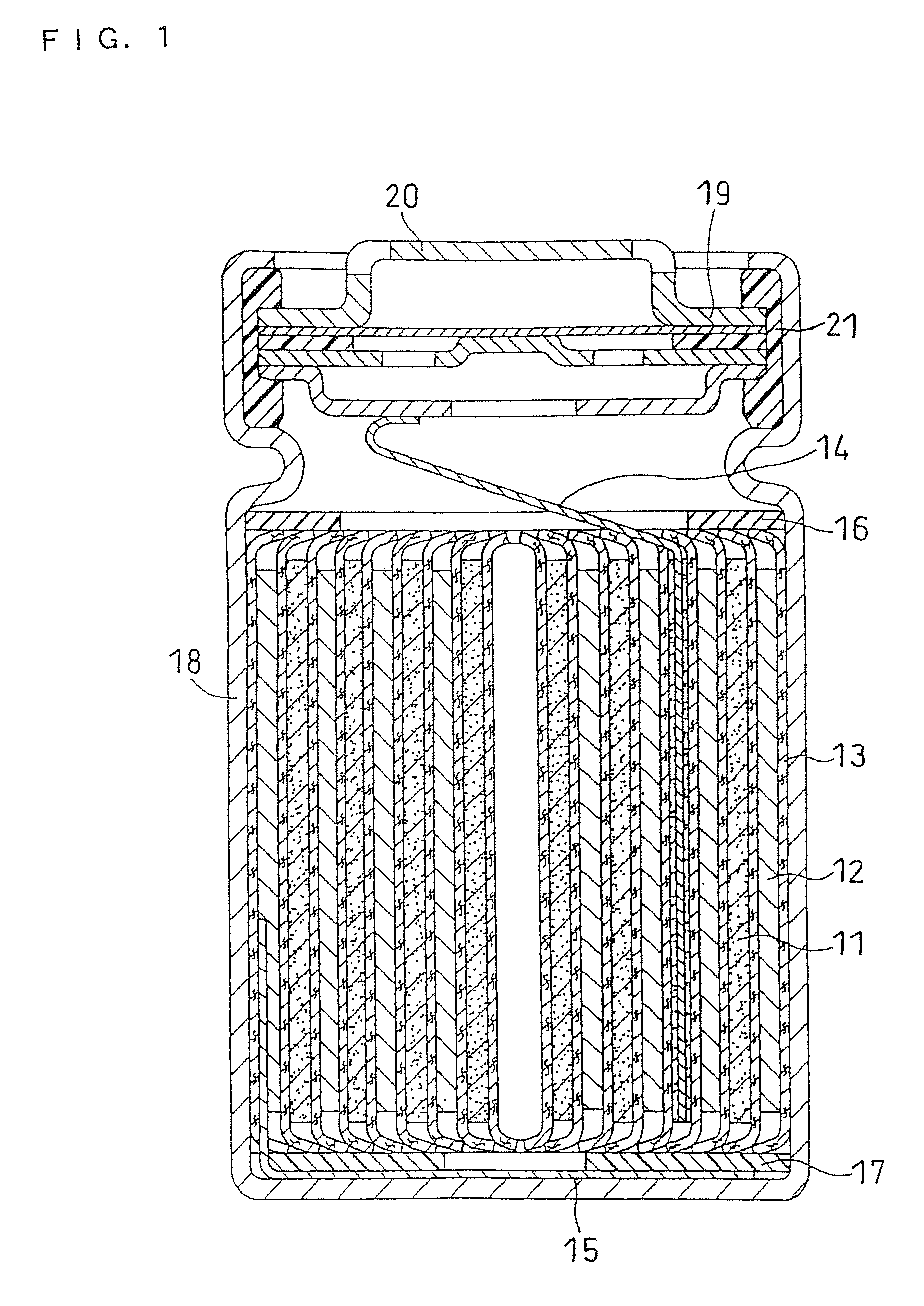Non-aqueous electrolyte secondary battery
a secondary battery, non-aqueous electrolyte technology, applied in the direction of non-aqueous electrolyte cells, cell components, electrochemical generators, etc., can solve the above-described elution of metal atoms from lithium-containing transition metal oxide, and the negative electrode's impedance increase cannot be suppressed,
- Summary
- Abstract
- Description
- Claims
- Application Information
AI Technical Summary
Benefits of technology
Problems solved by technology
Method used
Image
Examples
example 1
(Fabrication of Batteries 1 to 28)
[0087](i) Preparation of Non-Aqueous Electrolytes
[0088]In each of the non-aqueous solvents shown in Table 1, LiPF6 was dissolved in a concentration of 1.0 mol / L to prepare the non-aqueous electrolytes 1 to 28. It is to be noted that also in the following examples and comparative examples, the concentration of LiPF6 in each of the non-aqueous electrolytes was set at 1.0 mol / L.
[0089]In Table 1, the abbreviations for the used first solvents are as follows:
[0090]SL: Sulfolane
[0091]3MeSL: 3-Methylsulfolane
[0092]EMS: Ethyl methyl sulfone
[0093]AN: Acetonitrile
[0094]PN: Propionitrile
[0095]BN: Butyronitrile
[0096]TFETFPE: 1,1,2,2-Tetrafluoroethyl 2,2,3,3-tetrafluoropropyl ether
[0097]TFPDFME: 2,2,3,3-Tetrafluoropropyl difluoromethyl ether
[0098]MDFA: Methyl difluoroacetate
[0099]EDFA: Ethyl difluoroacetate
[0100]ETFEC: Ethyl 2,2,2-trifluoroethyl carbonate
[0101]DTFEC: Di-(2,2,2-trifluoroethyl)carbonate
[0102]MA: Methyl acetate
[0103]MP: Methyl propionate
[0104]GBL: γ...
example 2
[0135]Batteries 29 to 51 were obtained in the same manner as for the battery 5 except that the separators made of the materials as shown in Table 2 were used. In the same manner as described above, for each of the batteries 29 to 51, the metal deposition amount after storage and the capacity recovery rate after storage were evaluated. The results thus obtained are shown in Table 2. In Table 2, the results for the battery 5 are also shown.
[0136]In Table 2, the abbreviations for the materials of the used separators are as follows:
[0137]PFA: Tetrafluoroethylene-perfluoroalkyl vinyl ether copolymer
[0138]FEP: Tetrafluoroethylene-hexafluoropropylene copolymer
[0139]ETFE: Tetrafluoroethylene-ethylene copolymer
[0140]PVDF: Polyvinylidene fluoride
[0141]PCTFE: Polychlorotrifluoroethylene
[0142]PA: Polyamide
[0143]PI: Polyimide
[0144]PAI: Polyamideimide
[0145]PEI: Polyetherimide
[0146]PAR: Polyarylate
[0147]PSF: Polysulfone
[0148]PES: Polyethersulfone
[0149]PPS: Polyphenylenesulfide
[0150]PEEK: Polyether...
example 3
[0175]Batteries 52 and 53 were obtained in the same manner as for the battery 5 except that a polyethylene (PE) film that is a film resistant to reduction (Hipore™ manufactured by Asahi Kasei Chemicals Corporation, thickness 20 μm) and a polypropylene (PP) film that is a film resistant to reduction (Hipore™ manufactured by Asahi Kasei Chemicals Corporation, thickness 20 μm) were respectively laminated on the separator formed of PTFE. In the battery 52, the PTFE film was disposed on the side facing the positive electrode and the PE film was disposed on the side facing the negative electrode. Also, in the battery 53, the PTFE film was disposed on the side facing the positive electrode and the PP film was disposed on the side facing the negative electrode.
[0176]In the same manner as described above, for each of the batteries 52 and 53, the metal deposition amount after storage and the capacity recovery rate after storage were evaluated. The results thus obtained are shown in Table 3. I...
PUM
| Property | Measurement | Unit |
|---|---|---|
| thickness | aaaaa | aaaaa |
| mol % | aaaaa | aaaaa |
| thickness | aaaaa | aaaaa |
Abstract
Description
Claims
Application Information
 Login to View More
Login to View More - R&D
- Intellectual Property
- Life Sciences
- Materials
- Tech Scout
- Unparalleled Data Quality
- Higher Quality Content
- 60% Fewer Hallucinations
Browse by: Latest US Patents, China's latest patents, Technical Efficacy Thesaurus, Application Domain, Technology Topic, Popular Technical Reports.
© 2025 PatSnap. All rights reserved.Legal|Privacy policy|Modern Slavery Act Transparency Statement|Sitemap|About US| Contact US: help@patsnap.com


